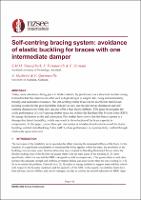| dc.contributor.author | Yousef-Beik, Seyed Mohammad Mehdi | |
| dc.contributor.author | Veismoradi, Sajad | |
| dc.contributor.author | Zarnani, Pouyan | |
| dc.contributor.author | Quenneville, Pierre | |
| dc.contributor.author | Hashemi, Ashkan | |
| dc.date.accessioned | 2020-06-18T13:43:12Z | |
| dc.date.available | 2020-06-18T13:43:12Z | |
| dc.date.issued | 2020-04-22 | |
| dc.identifier.uri | https://repo.nzsee.org.nz/xmlui/handle/nzsee/1708 | |
| dc.description.abstract | Today, more attention is being given to timber material by practitioners as a structural member owing to benefits that this material can offer such as high strength to weight ratio, being environmentally friendly and sustainable resources. The self-centring timber brace can be an efficient lateral load resisting system for the growing timber industry as they can provide energy dissipation and self-centring characteristic while they can also offer a high elastic stiffness. This paper investigates the cyclic performance of a self-centring timber brace that utilizes the Resilient Slip Friction Joint (RSFJ) for energy dissipation as the end connection. Past studies have shown that this brace is prone to a damage-free lateral instability, which may result in the reduction of the brace capacity in compression. In this paper, a new telescopic mechanism is introduced and tested to avoid the elastic buckling, entitled Anti-Buckling Tubes (ABT) whose performance is experimentally verified through a full-scale quasi-static test. | |
| dc.language.iso | en | |
| dc.publisher | New Zealand Society for Earthquake Engineering | |
| dc.relation.ispartofseries | 2020;64 | |
| dc.subject | Advances in earthquake engineering research | |
| dc.title | Self-centring bracing system: avoidance of elastic buckling for braces with one intermediate damper | |
| dc.type | Article | |

